beta(3)-adrenoceptor regulation and relaxation responses in mouse ileum
- PMID: 10725275
- PMCID: PMC1571941
- DOI: 10.1038/sj.bjp.0703160
beta(3)-adrenoceptor regulation and relaxation responses in mouse ileum
Abstract
1. This study examines the relationship between beta(3a)- and beta(3b)-adrenoceptor (AR) mRNA levels, beta(3)-AR binding and changes in ileum responses in mice treated with the beta(3)-AR agonist (R, R)-5-[2[[2-(3-chlorophenyl)-2-hydroxyethyl]-amino]-propyl]1, 3-benzodioxole-2,2-dicarboxylate (CL316243), or the beta(3)-AR antagonist 3-(2-ethylphenoxy)-1-[(1S)-1,2,3, 4-tetrahydronapth-1-ylamino]-2S-2-propanol oxalate (SR59230A), or dexamethasone or forskolin. 2. Levels of beta(3a)- and beta(3b)-AR mRNA and the maximum number of binding sites (B(max)) in ileum were unaffected following CL316243 treatment, although responses to CL316243 were reduced by 50% following 4 and 24 h treatment, indicating another desensitization mechanism not involving changes in receptor expression or number. beta(3a)-AR mRNA levels were reduced in both brown (BAT) and white adipose tissue (WAT) but beta(3b)-AR mRNA levels were significantly reduced only in WAT. Levels of beta(3a)- and beta(3b)-mRNA returned towards normal with continued treatment. 3. SR59230A treatment markedly increased beta(3)-AR mRN levels in ileum and BAT but not in WAT. The increase in beta(3)-AR mRNA levels in ileum was associated with increased B(max) levels in binding analysis and increased responses to CL316243, suggesting these as the cause of sensitization. 4. Treatment with forskolin (4 h) or dexamethasone (4 h) significantly reduced beta(3a)-AR mRNA levels in BAT and WAT but did not alter levels in ileum. Responses to CL316243 in ileum were unaffected by either treatment. 5. In summary, the beta(3)-AR is differently regulated in adipose tissue and ileum: Treatment with SR59230A increased beta(3)-AR number, mRNA and responsiveness in ileum, whereas treatment with CL316243 reduced responses without affecting beta(3)-AR number or mRNA levels.
Figures

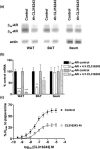
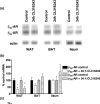
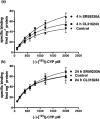

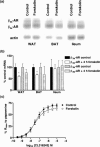
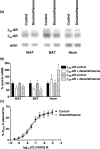
Similar articles
-
Differential regulation of beta3-adrenoceptors in gut and adipose tissue of genetically obese (ob/ob) C57BL/6J-mice.Br J Pharmacol. 1998 Jun;124(4):763-71. doi: 10.1038/sj.bjp.0701867. Br J Pharmacol. 1998. PMID: 9690869 Free PMC article.
-
beta(1)-Adrenoceptors compensate for beta(3)-adrenoceptors in ileum from beta(3)-adrenoceptor knock-out mice.Br J Pharmacol. 2001 Jan;132(2):433-42. doi: 10.1038/sj.bjp.0703828. Br J Pharmacol. 2001. PMID: 11159692 Free PMC article.
-
Characterization of beta-adrenoceptor mediated smooth muscle relaxation and the detection of mRNA for beta1-, beta2- and beta3-adrenoceptors in rat ileum.Br J Pharmacol. 1999 Jun;127(4):949-61. doi: 10.1038/sj.bjp.0702605. Br J Pharmacol. 1999. PMID: 10433503 Free PMC article.
-
Structure and function of the beta 3-adrenergic receptor.Annu Rev Pharmacol Toxicol. 1997;37:421-50. doi: 10.1146/annurev.pharmtox.37.1.421. Annu Rev Pharmacol Toxicol. 1997. PMID: 9131260 Review.
-
On the presence of a putative fourth beta-adrenoceptor in human adipose tissue.Trends Pharmacol Sci. 1998 May;19(5):164-6. doi: 10.1016/s0165-6147(98)01199-7. Trends Pharmacol Sci. 1998. PMID: 9652187 Review. No abstract available.
Cited by
-
Agonist-induced desensitisation of β3 -adrenoceptors: Where, when, and how?Br J Pharmacol. 2019 Jul;176(14):2539-2558. doi: 10.1111/bph.14633. Epub 2019 Apr 7. Br J Pharmacol. 2019. PMID: 30809805 Free PMC article. Review.
-
Is the β3-Adrenoceptor a Valid Target for the Treatment of Obesity and/or Type 2 Diabetes?Biomolecules. 2023 Nov 28;13(12):1714. doi: 10.3390/biom13121714. Biomolecules. 2023. PMID: 38136585 Free PMC article. Review.
-
Agonist-induced desensitization of human β3-adrenoceptors expressed in human embryonic kidney cells.Naunyn Schmiedebergs Arch Pharmacol. 2013 Oct;386(10):843-51. doi: 10.1007/s00210-013-0891-y. Epub 2013 Jun 12. Naunyn Schmiedebergs Arch Pharmacol. 2013. PMID: 23756578
-
Do β-adrenoceptor agonists induce homologous or heterologous desensitization in rat urinary bladder?Naunyn Schmiedebergs Arch Pharmacol. 2014 Mar;387(3):215-24. doi: 10.1007/s00210-013-0936-2. Epub 2013 Nov 10. Naunyn Schmiedebergs Arch Pharmacol. 2014. PMID: 24213882
-
Role of beta3-adrenergic receptors in the action of a tumour lipid mobilizing factor.Br J Cancer. 2002 Feb 1;86(3):424-8. doi: 10.1038/sj.bjc.6600086. Br J Cancer. 2002. PMID: 11875710 Free PMC article.
References
-
- ARCH J.R., AINSWORTH A.T., CAWTHORNE M.A., PIERCY V., SENNITT M.V., THODY V.E. Atypical β-adrenoceptor on brown adipocytes as target for anti-obesity drugs. Nature. 1984;309:163–165. - PubMed
-
- BENGTSSON T., REDEGREEN K., STROSBERG A.D., NEDERGAARD J., CANNON B. Down-regulation of β3 adrenoceptor gene expression in brown fat cells is transient and recovery is dependent upon a short-lived protein factor. J. Biol. Chem. 1996;271:3366–3375. - PubMed
-
- BENSAID M., KAGHAD M., RODRIGUEZ M., LE FUR G., CAPUT D. The rat β3-adrenergic receptor gene contains an intron. FEBS. 1993;318:223–226. - PubMed
-
- BRAY G.A., YORK D.A. Hypothalamic and genetic obesity in experimental animals: an autonomic and endocrine hypothesis. Physiol. Rev. 1979;59:719–809. - PubMed
-
- COLEMAN R.A., DENYER L.H., SHELDRICK K.E. β-Adrenoceptors in guinea-pig gastric fundus–are they the same as the ‘atypical' β-adrenoceptors in rat adipocytes. Br. J. Pharmacol. 1987;90:40P.
Publication types
MeSH terms
Substances
LinkOut - more resources
Full Text Sources
Other Literature Sources
Research Materials

